Are you delving into the world of aquarium keeping and wondering which freshwater fish would be the perfect fit for your new tank? Selecting the ideal fish, especially for beginners, involves finding a balance between hardiness, captivating appearance, and fascinating behavior. In this comprehensive guide, I’ve curated a list of the top seven freshwater aquarium pet fish tailored specifically for novice enthusiasts. So, let’s dive in and explore the diverse array of options that await you in the realm of freshwater fishkeeping.

Cherry picking the very best freshwater aquarium fish for beginners is not the easiest job but I think I managed.
In my experience, what makes a pet fish good for a beginner is the fish being hardy while still having an interesting appearance and behavior.
These traits kind of narrowed down the list.
So let me show you what I think are the 7 best freshwater pet fish for a complete beginner in the hobby.
Top 7 Freshwater Aquarium Pet Fish for Complete Beginners
There are thousands of interesting pet fish you could keep in your aquarium but some of them are either too sensitive and require special care or need a really big tank.
The ones I’m listing here have the best of both worlds – they look great in a tank and are also easy to look after if you’re doing this for the first time.
Here are the best freshwater aquarium fish for complete beginners:
1. Swordtails – Xiphophorus hellerii

Swordtails are gracious live-bearing fish from the genus Xiphophorus.
They have that exotic look to them and are some of the hardiest pet fish out there.
The swordtails’ bright orange color makes them easy to notice from across the room and their long needle-like tail is a great conversation starter for when you have guests over.
These tropical fish feel the best when in groups of at least seven specimens.
This is probably the only rule you need to follow if you’re keeping these low-maintenance fish.
The males are the ones with the spike on the tail.
A quick Swordtails info cheatsheet:
- Maximum Body Size: 4.2 inches or 10.6 cm with the tail
- Minimum Tank Size: 20 gallons
- Water Temperature Range: 71°F to 77°F (21 to 25°С)
- Key Traits: should be kept in groups, very hardy, exotic look
2. Bristlenose Pleco – Ancistrus spp.

Bristlenose plecos are small catfish from the Ancistrus genus and bear cool whiskers sprouting from their faces.
They are a type of armored catfish, which means their scales resemble armor, another unique trait among freshwater fish.
Bristlenose plecos use their mouths to attach themselves on different surfaces in the aquarium.
They mainly roam the bottom of a fish tank and are excellent cleaner fish.
If you’re looking for a fish with exotic appearance that will also help you maintain the bottom of your new fish tank clean, the Bristlenose pleco may be the best option for you.
A quick Birstlenose pleco info cheat sheet:
- Maximum Body Size: between 3 and 6 inches depending on the sub-species
- Minimum Tank Size: 30 gallons for the largest varieties
- Water Temperature Range: 65 – 79°F (18 – 26°C)
- Key Traits: exotic appearance, calm, may eat algae and helps clean the tank
3. Betta fish – Betta splendens

Betta fish are one of the most popular freshwater fish for beginners in our hobby.
The beautiful fins of the males are their most recognizable trait.
Females are less popular because they don’t have the large fin and tails of ornamental males.
What’s most exciting about Bettas, aside from their looks, is that they come with tons of personality.
Each Betta will have its own character. What unites them in that regard is that they can be quite feisty.
This does include being an overly aggressive little monster but that’s part of the fun when keeping a Betta.
They show their aggression by opening their gills in an attempt to appear scary.
Because of their short temper Bettas are best kept alone if you’re a beginner.
This makes them a good starter fish for someone who wants a small tank.
The classic Betta setup is a small 5-gallon tank with a single male specimen and some plants.
Bettas really like relaxing their nerves on the leaves of plants near the water surface when they’re not busy being angry at everyone.
A quick Betta info cheat sheet:
- Maximum Body Size: 2.7 inches on average (6.8 cm)
- Minimum Tank Size: 3 gallons but I strongly recommend you get them 5
- Water Temperature Range: 75°F to 82°F (24 to 28°C)
- Key Traits: feisty, odd personality, beautiful fins, best kept alone
4. Zebra Danio – Danio rerio
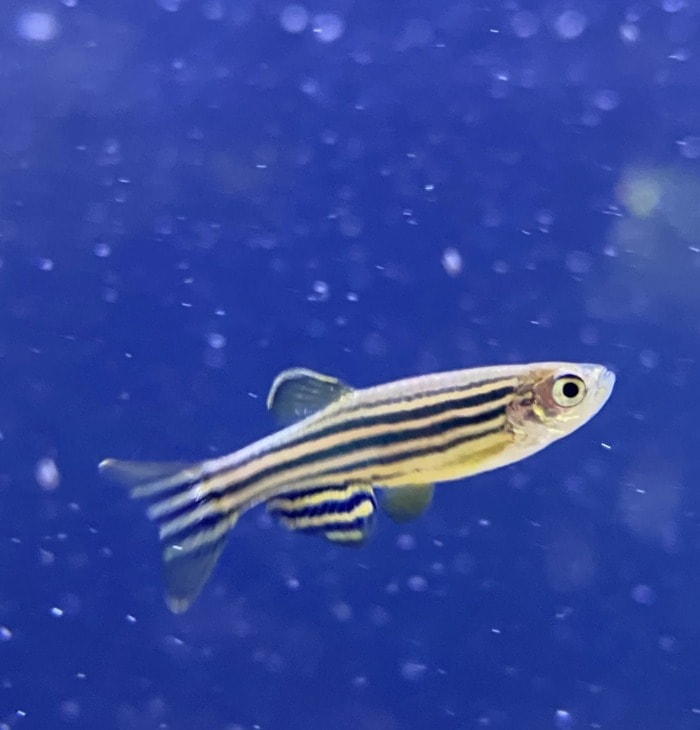
The Zebra Danio are restless little fish from the Danio genus, that take being hyperactive to another level.
These hardy fish swim back and forth like their lives depend on it.
I’d recommend getting them if you want a fish tank that appears bustling with life.
Zebra Danios look almost artificially colored. They have long dark-blue stripes across the length of their bodies.
This type of coloration is quite unique in the world of freshwater fish since there are very few species that boast a blue body color.
Zebra Danios need a long tank where they can cover a decent distance and speed up before having to turn around.
They are a type of schooling fish, which means they will harmoniously swim together.
Zebra Danios should be kept in groups (also known as schools) of at least 6 to 7 specimens.
A quick Zebra Danio info cheat sheet:
- Maximum Body Size: 2.2 inches on average (5.6 cm)
- Minimum Tank Size: 20-gallon “Long” Tank
- Water Temperature Range: 64 to 76°F (17 to 25°C)
- Key Traits: relentless swimmer, interesting coloration, needs to be kept in groups, needs a long tank, does great in cool temperatures
5. Fancy Guppies – Poecilia reticulata
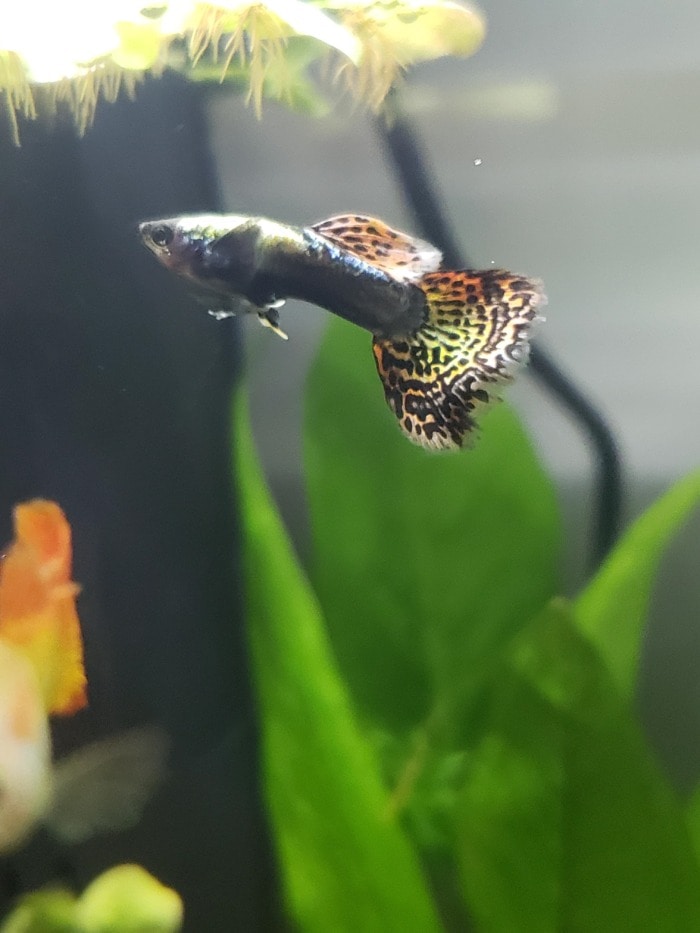
Fancy guppies are maybe the best known freshwater fish in the world.
Their extreme popularity comes from the fact that they have tons of color variations and also possess unsurpassed hardiness.
Guppies are so flexible when it comes to surviving that they basically thrive in home fish tanks, even as a starter fish.
They also multiply like crazy, which should be taken under consideration if they are your first fish of choice.
They do best in large groups because they are social animals.
A fancy guppy community tank is actually one of the classic setups for beginners.
Keeping a large community of fancy guppies makes it seem like their aquarium is “trembling” with their colorful tails always wiggling.
A quick Fancy Guppy info cheat sheet:
- Maximum Body Size: 2.5 inches (6.35 cm)
- Minimum Tank Size: 5-gallon tank for 3 guppies but a 10-gallon one is better
- Water Temperature Range: 55 – 86°F (13 – 30°C) as they are very versatile in that regard but it’s best to keep them in the range of 72 to 80°F (22 to 26.6°C)
- Key Traits: hundreds of colorful varieties, hardy, likes hard water, breeds fast
6. Albino Bronze Cory – Corydoras aeneus
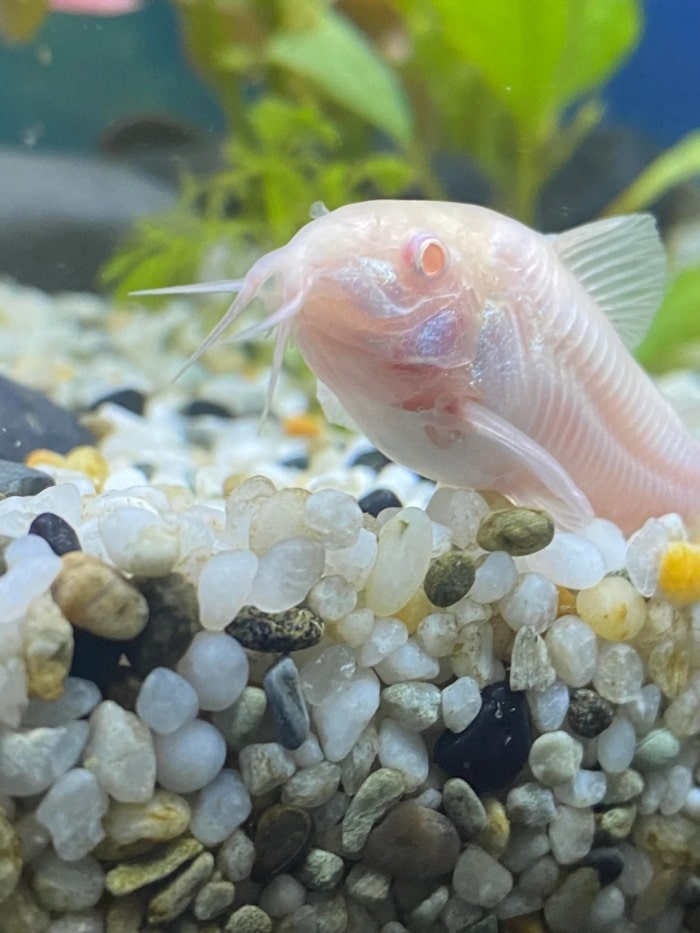
The Bronze Cory catfish is one of the 160 tropical species within the Corydoras genus.
The albino version of the Bronze Cory makes an attractive addition to any tank, in my opinion.
Cory catfish kind of resemble plecos in appearance but have a more oval shape and swim more like a real fish, whereas the plecos would glue themselves to surfaces.
The cute Bronze Cory has an average lifespan of 10 years, which makes it a long-term commitment.
Bronze Cories need to be kept in groups of at least 5 to thrive in a home aquarium.
The best part is that these fish are super social and will literally stick together wherever they go in the aquarium.
Like a little Cory gang in your tank…
A quick Albino Bronze Cory info cheat sheet:
- Maximum Body Size: 2.5 inches or 6.35 cm
- Minimum Tank Size: 10 gallons but a 20-gallon tank is way better for them
- Water Temperature Range: 20 to 28°C (68 to 82°F)
- Key Traits: Likes to hang out with its brothers in the tank, bottom dweller, has long lifespan upon good care
7. Ember Tetra – Hyphessobrycon amandae
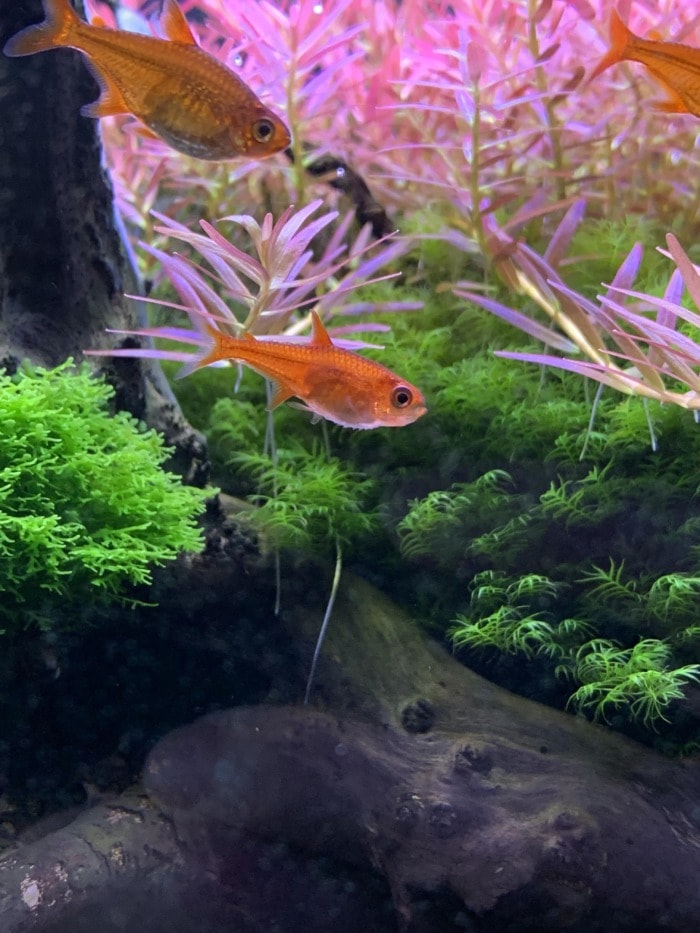
Ember tetras are schooling nano fish coming from a genus with a weird and long name – Hyphessobrycon.
These tiny fish have bright orange colors that stand out great in a tank with lots of green plants.
Ember tetras should be kept in groups to feel comfortable.
When in a decently large group their dash-style swimming is very interesting to observe.
Ember tetras are maybe one of my favorite nano tetras alongside Neon tetras.
Ember tetras keep a tank lively which is something you’d want to see as a beginner.
Just remember they will be kind of shy at first because they need some time to settle and become bolder since they are so small.
A quick Ember Tetra info cheat sheet:
- Maximum Body Size: 0.7 inches (1.8 cm)
- Minimum Tank Size: 10 gallons for a decent school of 10+ tetras
- Water Temperature Range: 71.6 to 83.3°F or 22 to 28.5°C
- Key Traits: remains small, should be kept in a school, bright colors, stands out in planted tanks
What Equipment Do You Need to Start a Fish Tank?
There are four essential pieces of equipment that your fish tank absolutely needs to run properly. These are:
- A filter
- A heater
- Lights
- Water conditioners
The filter will keep your new pet fish alive for more than 7 days. Which is great.
The heater will keep the water at a temperature suitable for your fish, which helps with their immune system and metabolism.
Aquarium lighting controls how much light enters your tank and helps with the sleep cycle of fish.
Water conditioners keep the water safe for live fish.
Ideally, you’d want to get a water testing kit to check the parameters in emergencies.
Skim through my aquarium equipment checklist where I explain all of this in more detail. I also include optional pieces of equipment which, as you will see, can be very helpful with the whole tank maintenance thing.
What Do You Need to Do Before Adding Fish to Your New Aquarium?
You’d want to “cycle” your aquarium before adding any fish to it.
If you add pet fish to the tank too soon and before it was cycled the fishes will likely die right away.
To cycle a tank basically means to kickstart the beneficial bacteria inside that would help recycle waste created by fish poop.
When fish poop ammonia is released in the water which is toxic to fish and could kill them.
If there is beneficial bacteria in the tank, however, they immediately take up that ammonia and transform it to something called Nitrate.
Nitrate is not immediately toxic to your fish which gives you time to remove it from the aquarium through changing portions of the water over time.
Since tank cycling can take more than a month, I’ve described a fast way to do so here.
The article in the link uses something called aquarium bacteria starters.
These aquarium starters are basically bottles with inactivated bacteria that speed up the process significantly.
Aquarium Maintenance and Fish Care Tips for Beginners
So after your new aquarium is up and running with live fish in it, there’s only one thing you need to do from here on:
Keep it clean.
A clean aquarium (both the tank and its water) prevents the majority of issues you could face down the line. These issues include fish illness or fatalities and ugly algae outbreaks.
There are three simple steps you’d want to follow to keep a fish tank clean:
- Change about 20% of the water every two weeks.
- Vacuum the bottom of the tank every 2 to 3 weeks to remove fish poop and uneaten fish foods.
- Feed your fish mindfully and never overfeed them.
Technically, vacuuming the bottom of the tank and changing a portion of the water can be done simultaneously if you have a handy siphon tool for the job. The siphon sucks nasties from the bottom along with some of the dirty water.
And finally, to prevent the tank from getting dirty in the first place you should just be mindful not to overfeed your fish.
Feed your pet fish small pinches of food and no more than what they can eat in 3 minutes.
For further guidance on how much and how often to feed your fish give this article a read.
My Conclusion

Fish keeping can be a very rewarding hobby, especially because there’s always something new to learn.
This plethora of knowledge eventually makes you feel very smart and capable.
However, we should not unnecessarily complicate things.
Pet fish like the Swordtails, Fancy Guppies, and Zebra Danios are among the easiest to take care of even if you’re a complete beginner.
Which one did you choose for your new aquarium?
Leave me a comment below.


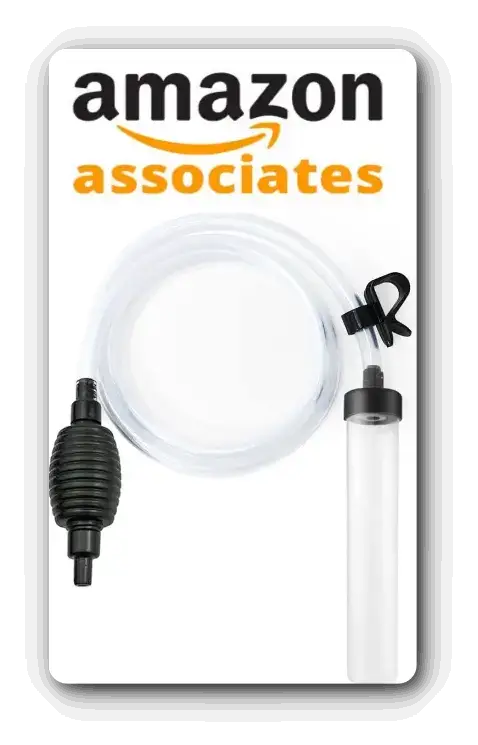

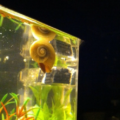

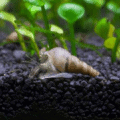

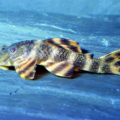
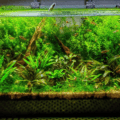
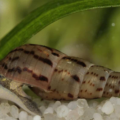

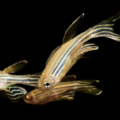
5 thoughts on “7 Best Freshwater Aquarium Fish for Complete Beginners”